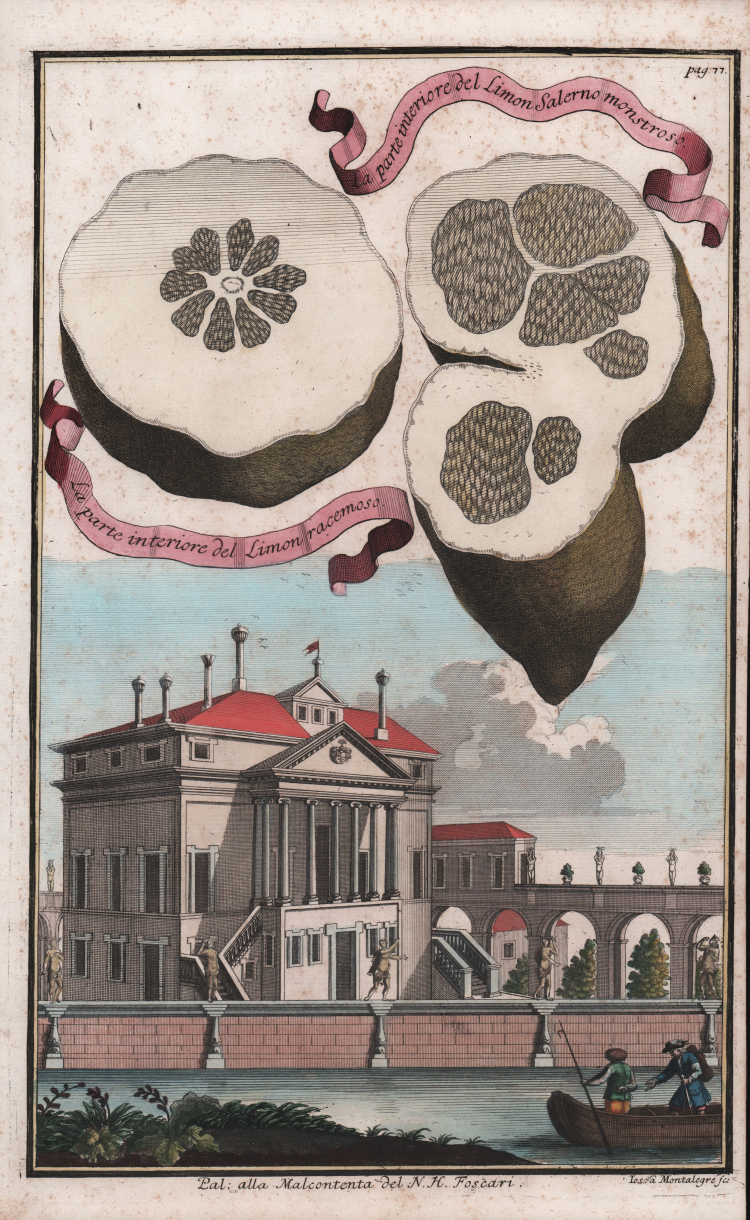



| Reference: | S46826 |
| Author | Joahnnes VOLCKAMER |
| Year: | 1710 ca. |
| Printed: | Nurnberg |
| Measures: | 205 x 325 mm |


| Reference: | S46826 |
| Author | Joahnnes VOLCKAMER |
| Year: | 1710 ca. |
| Printed: | Nurnberg |
| Measures: | 205 x 325 mm |
Plate from Volckamer (Volkamer), Johann Christoph: "Nurembergische Hesperides, oder gruendliche Beschreibung der edelen Citronat-, Citronen und Pomeranzen-Fruechte, wie solche in selbiger und benachbarten Gegend, recht mögen eingesetzt, gewartet, erhalten und fortgebracht werden. Sampt einer ausführlichen Erzehlung der meisten Sorten, welche theils zu Nürnberg würcklich gewachsen, theils von verschiedenenen fremden Orten dahin gebracht worden..." und "Continuation der Nürnbergischen Hesperidum, oder fernere gründliche Beschreibung....".
Johann Volkamer was a wealthy Nuremberg merchant who owned magnificent orchards and a beautiful orangery. At his own expense, he hired numerous draftsmen and engravers to execute depictions of his fruits, which he published under the title Nurnbergische Hesperides, with over 100 plates. Unlike other botanical engravings of the 18th century, which have plain backgrounds, Volckamer filled the lower part of his plates with views of palaces, gardens and landscapes in Germany, Austria and Italy. These delightful additions make Volckamer's engravings particularly attractive.
In particular, he placed them in and around his city of Nuremberg in northern Italy, especially in the Verona area. The plates were engraved by Paulus Decker the Elder, L.C Glotsch, B. Kenckel, C.F. Krieger, J. A. Montalegre, W. Pfan, and J.C. Steinberger. Preparatory work for this complete work dates from 1695.
Etching, finely hand-colored, slight oxidation, otherwise in excellent condition.
Joahnnes VOLCKAMER (1644 - 1720)
|
Johann Christoph Volkamer (also: Volcamer, Volckamer, Volkammer, Volcameris) was the son of the physician Johann George Volkamer. He was occupied by hobby with the botany and maintained a garden in the today's Nurembergian Gostenhof district. He published 1708-1714 a two volume work over citrus under the title "Nurenbergische Hesperides, the thorough description of the noble Citron, used in within and neighbouring area, praised Lemon, and Orange fruits, like such, be received and carried away, velvet of a detailed dicription of most sorts, which some were brought to Nuremberg actually grown, others by different strange places there... "
In Volkamers time one saw the "Goldenen of apples in the citrus fruits Hesperides" the Greek mythology. Starting from late 17th Century developed a collecting passion for instance at the aristocracy, with which each tried to exceed the other one with the rarest and monsterious fruits.
With this work the term became "Hesperides" to the symbol for the flowering Nurembergian garden culture, those for instance lasted from 1650 on, up to the end 18th Century.
In Volkamers book he illustrated also Nurembergian landscapes, city opinions and above all gardens of the city, become in beside the Citrus plants and their fruits illustrated by engraving.
He is said to be influenced from the work of Giovanni Baptista Ferrari.
|
Joahnnes VOLCKAMER (1644 - 1720)
|
Johann Christoph Volkamer (also: Volcamer, Volckamer, Volkammer, Volcameris) was the son of the physician Johann George Volkamer. He was occupied by hobby with the botany and maintained a garden in the today's Nurembergian Gostenhof district. He published 1708-1714 a two volume work over citrus under the title "Nurenbergische Hesperides, the thorough description of the noble Citron, used in within and neighbouring area, praised Lemon, and Orange fruits, like such, be received and carried away, velvet of a detailed dicription of most sorts, which some were brought to Nuremberg actually grown, others by different strange places there... "
In Volkamers time one saw the "Goldenen of apples in the citrus fruits Hesperides" the Greek mythology. Starting from late 17th Century developed a collecting passion for instance at the aristocracy, with which each tried to exceed the other one with the rarest and monsterious fruits.
With this work the term became "Hesperides" to the symbol for the flowering Nurembergian garden culture, those for instance lasted from 1650 on, up to the end 18th Century.
In Volkamers book he illustrated also Nurembergian landscapes, city opinions and above all gardens of the city, become in beside the Citrus plants and their fruits illustrated by engraving.
He is said to be influenced from the work of Giovanni Baptista Ferrari.
|